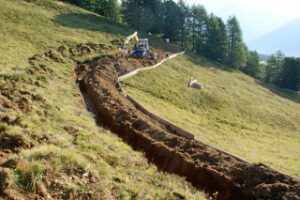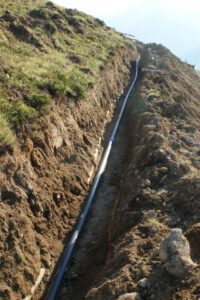Water Supply
Water Supply





41 springs – the heart of our nature
The Schatzalp is home to 41 springs, which form the heart of our nature and are the lifeline of this unique Alpine landscape. These springs are far more than just natural watercourses – they embody the purity and power of untouched nature. Each of these springs has its own character and contributes to the diversity and beauty of the surroundings. From the hidden, quiet springs in the dense forests to the lively watercourses in the open meadows – each spring is a jewel that has been part of the natural balance of the region for centuries.
Water supply – a link to history
The importance of water for the Schatzalp stretches far back into the past. Interestingly, the Schatzalp was never connected to the water supply of the municipality of Davos and has always been self-sufficient – from the time of the sanatorium in 1900 until April 1953, when the hotel was built. This self-sufficiency has always been a central component of the Schatzalp. Even today, it is still the unshakeable basis for our sustainable use of water. The Schatzalp springs were and still are the key to our water supply.
We know from historical records that the Schatzberg was already a permanent settlement in the Middle Ages. This early settlement, which was later used as a Maiensäss, benefited from the nearby water sources, which were piped to the houses and stables. The oldest surviving relics of this water supply are brick well intakes and iron water pipes, which have been preserved to this day and give us an insight into the engineering skills of the time. The Accola farm in particular is known for its well-preserved water supply, which shows how important water was for the inhabitants of the region even back then.
Regular renovation work
In order to combine the historical infrastructure with the requirements of modern times, regular renewal work is essential. Our water supply network, some of which still consists of old clay pipes, is constantly being modernized. In areas such as the Podestatenalp, we are replacing the outdated clay pipes with modern materials that guarantee a long-term supply. The old pipes, consisting of composite clay elements, are visible in the pictures next to the new pipes and offer a fascinating insight into the development of water technology.
This renovation work is an essential part of our sustainable water supply. They ensure not only the best quality, but also the availability of sufficient quantities.
Water is life
Water is life – an indispensable element that forms the basis of all life. The 41 springs of the Schatzalp provide crystal-clear, fresh water, which not only supplies the botanical garden Alpinum Schatzalp, but also refreshes the guests of the hotel. The water flows from the springs into two water reservoirs above the hotel, which serve as storage tanks and ensure a constant supply. These reservoirs are an indispensable part of our water system and contribute significantly to the stability and efficiency of the supply. They symbolize the water cycle and its central role in life on the Schatzalp.
Powerful, clear & irreplaceable
The Schatzalp springs are powerful, clear and irreplaceable. They flow with an energy that shapes and enriches life in the region. Their water is pure, untouched and unpolluted due to the lack of agriculture. A reflection of the untamed, clear nature that surrounds us. Along the hiking trail, the beautiful water clock invites you to experience the timelessness and constant power of water. This clock, fed by the springs, provides hikers and visitors with information about the water level in the drinking water reservoir and is a reminder of how closely nature and time are connected. It is a symbol of the continuous movement of water and the irreplaceability of this resource.
Modern water supply and historical treasures
The water that reaches the Schatzalp takes a long journey through kilometers of pipes. It is collected in a two-chamber reservoir located around 60 meters above the hotel. This reservoir is divided into two chambers: the first chamber, with a capacity of 140 cubic meters, serves as a fire water reserve that is exclusively available to the fire department. As soon as this tank is full, the water flows into the drinking water reservoir and supplies the hotel’s guests with water. This division guarantees efficient use and storage of the water and ensures that there is always enough water available to meet demand.
Strict quality controls
The quality of the water is our top priority. Each of the 41 springs is continuously monitored and samples are taken monthly by our in-house water warden and tested in specialized laboratories. These strict controls guarantee that our water always meets the highest standards for drinking and table water. Regular inspections by the relevant authorities confirm that our water is not only safe to drink, but also safe for health. This care reflects our commitment to excellence and our endeavor to offer Schatzalp guests only the best.
Sustainable enjoyment from our springs
In order to safeguard the valuable resources of our 41 springs in the long term, we offer fresh spring water directly from our own water dispensers in our restaurants. We deliberately avoid transportation and packaging waste and use specially produced glass bottles. The water is bottled fresh every day and can be carbonated on request. The income from sales goes towards maintaining and renewing our spring infrastructure. This sustainable approach ensures that our guests can enjoy pure, refreshing spring water while at the same time protecting the environment and preserving the treasures of the Schatzalp for future generations.
Sustainability and protection
Sustainability is at the heart of our philosophy. The use of the two water reservoirs above the hotel, the regular maintenance of the water pipes and our conscious use of the water sources are crucial to preserving Schatzalp’s precious resources for future generations. Our sustainable practices aim to respect nature and protect the irreplaceable springs. The beautiful water clock along the hiking trail symbolizes not only the connection between time and nature, but also our commitment to protecting and preserving these unique treasures.
Hiking trails – Discover the springs
For those who want to experience the power of water and the beauty of the surroundings at first hand, there are two unforgettable hiking trails. The waterfall walk leads along a small, seasonally flowing waterfall over a distance of 4.5 km. Depending on the season and water level, the intensity of this natural spectacle, which appears almost still in quieter months, varies. The sun trail, 2.5 km long, runs through idyllic forest and meadow landscapes and invites you to enjoy the tranquillity of the surroundings. Both hiking trails lead past the two water reservoirs and the beautiful water clock, which provides hikers and visitors with information about the water level in the drinking water reservoir and helps them to understand the fascinating interplay between nature, water and time. This interplay can be particularly admired in the Guggerbachtal-Alpinum. Please note that the springs themselves are not open to the public in order to preserve their pristine nature.
Experience the Schatzalp – a place where the 41 springs form the heart of our nature, where water is life, and the power, clarity and irreplaceability of our resources can be felt in every drop.
